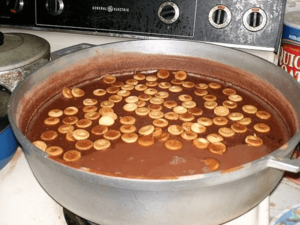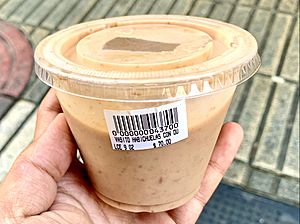Habichuelas con dulce facts for kids

Habichuelas con dulce
|
|
| Type | Dessert |
|---|---|
| Place of origin | |
| Region or state | Latin America, Caribbean |
| Main ingredients | Red beans, cinnamon, nutmeg, coconut milk, evaporated milk, raisin, sugar, pinch of salt and vanilla |
Habichuelas con dulce is a yummy sweet bean dessert from the Dominican Republic. It's super popular, especially around the Easter holiday! This special treat is a big part of the food culture in the Dominican Republic. People often enjoy it with milk cookies or a type of flatbread called casabe, which is made from yuca flour.
This delicious dessert is made with red beans, cinnamon, nutmeg, coconut milk, evaporated milk, raisins, sugar, and a little salt. The beans are first boiled with cinnamon sticks and sweet cloves. Then, they are blended until they are smooth like a soup. Coconut milk and evaporated milk are added next, along with cooked sweet potato chunks. Sometimes, cooks also add cloves and ginger for extra flavor.
Contents
The Story Behind Habichuelas con Dulce
No one is completely sure where Habichuelas con dulce first came from. There are a few interesting ideas about its history.
African Roots Theory
One idea is that this dish was created by enslaved African people who were brought to the Dominican Republic long ago. It's similar to a dish called frejol colado from Peru. Frejol colado is made by Afro-Peruvians using black beans, milk, and sugar. Some food historians think Habichuelas con dulce might be like a long-lost cousin to frejol colado.
Turkish Connection Theory
Another theory suggests that Habichuelas con dulce might have come from a Turkish dish called Aşure, also known as “Noah’s Pudding.” If this is true, Aşure might have traveled to the Dominican Republic in the late 1800s or early 1900s. Immigrants from the former Ottoman Empire brought many classic dishes with them, like Taboulleh and Kibbeh. Aşure is made with similar ingredients, including sugar, beans, and spices. Just like Habichuelas con dulce, Aşure is also linked to a religious time of fasting. In the Islamic calendar, people fast for the first 10 days of Muharrem. On the 10th day, they cook and share Aşure with friends and family. This theory suggests that Aşure slowly changed into Habichuelas con dulce.
Colonial Mix Theory
Some people believe that Habichuelas con dulce developed during the time when the Dominican Republic was a colony. They think it's a mix of different cultures:
- Sugar and coconut milk came from African traditions.
- Sweet potato came from the native Taino people.
- Beans and spices came from Spanish settlers.
French Influence Theory
There's also a theory that the dish has French roots. The Dominican culture was shaped by a mix of European, African, and mixed-race people, plus many immigrants. A French military man named Dorvo Soulastre visited Santo Domingo in 1798. He met a Frenchman named Francois Delalande, who was said to have introduced the custom of eating beans.
Delalande had moved to Santo Domingo after a sad family event. Soulastre wrote about eating "sugary beans" prepared in Santo Domingo during Easter in 1798. Even with all these ideas, how the dish truly started is still a mystery!
How Habichuelas con Dulce Is Made
Red beans are the main ingredient for Habichuelas con dulce. First, the beans need to be very soft, so they are often soaked in water overnight. After soaking, they are boiled until they are tender. Then, the beans are strained to make sure the mixture is smooth.
Next, evaporated milk, condensed milk, and coconut milk are added to the blended beans. Many families add different spices to make it taste even sweeter. Common spices include cinnamon, cloves, nutmeg, and vanilla. The exact spices depend on the family's special recipe. After mixing everything, a little butter is often added.
Traditional toppings and things mixed in include raisins, batata (which is white sweet potato), and Guarina milk cookies. Habichuelas con dulce is usually left to cool down for a few hours before it's ready to eat.
Similar Sweet Bean Dishes Around the World
A similar sweet bean paste, often dark red, is used in many Asian cuisines. It's called red bean paste.
Chinese Cuisine
In Chinese cooking, red bean paste is used in:
- Zongzi: These are sticky rice dumplings with different fillings, wrapped in leaves.
- Jiān dui: These are fried pastries made from sticky flour, sometimes filled with red bean paste.
- Mooncakes: These have a rich, thick filling often made with lotus seed paste or red bean paste.
- Red bean cake: This is made from mashed beans mixed with gelatin, then cooled.
Korean Cuisine
In Korea, you can find red bean paste in:
- Bungeoppang: A fish-shaped pastry that is roasted and filled with red bean paste.
- Hobbang: A soft, round bun filled with red bean paste.
- Baram tteok: A type of rice cake filled with red bean paste.
- Chalboribbang: Small, sweet pancakes that use a spread made of red bean paste.
Japanese Cuisine
In Japan, red bean paste is a popular filling for many sweets:


